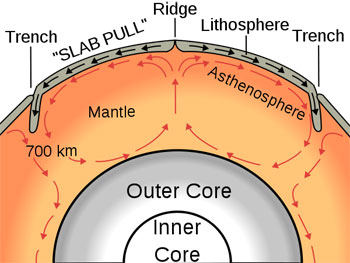Mystery ‘earmuffs’ sit deep inside Earth
A new study of the mineral bridgmanite give clues to strange gigantic blobs deep inside Earth

To reproduce the extreme pressures found in the lower mantle, Jackson and her team used a diamond anvil cell like this one.
Steve Jacobsen/Northwestern University
By Beth Geiger
Deep within the Earth are two huge, mysterious blobs. They are about 1,500 kilometers (932 miles) below the planet’s surface. One sits beneath Africa. The other lies under the Pacific Ocean. Now, a team of mineralogists has found new clues to what makes up the blobs — and possibly what caused them.
Each blob is the size of a continent, towering 1,500 kilometers (932 miles) high. They are positioned on opposite sides of Earth, “like earmuffs,” says Ed Garnero. He is a geophysicist at Arizona State University in Tempe. Garnero specializes in studying the mantle.
Both blobs, also called piles, live in Earth’s lower mantle. The mantle is the thick, hot, semi-solid layer that extends from about 5 kilometers (3.1 miles) to 2,900 kilometers (1,800 miles) below Earth’s surface. The deeper half of the mantle, starting at about 670 kilometers (416 miles) down, is called the lower mantle. Temperatures there reach a scorching 2,127° Celsius (3,860° Fahrenheit). And the pressures can be 1.3 million times as high as on Earth’s surface!

Jennifer Jackson is a physicist who studies minerals at the California Institute of Technology in Pasadena. Recently, she and a team of scientists looked for clues to the big blobs in tiny specks of bridgmanite (BRIDG-maan-ite). This is a high-pressure form of the mineral pyroxene (Py-ROX-een). Bridgmanite is Earth’s most abundant mineral. It makes up about 70 percent of the lower mantle. Jackson now suspects that it might make up nearly 100 percent of the blobs.
How they studied the mineral
Natural bridgmanite does not exist on Earth’s surface. So Jackson and her colleagues created it in the laboratory. They squeezed specks of pyroxene. Their tool: a diamond anvil cell. In doing so, the mineral encountered the extreme pressures and temperatures typical of the mantle. That turned the pyroxene into bridgmanite.
Then the scientists studied how this mineral behaved. For example, they looked into how dense bridgmanite becomes and how much it squashes. The team then compared these traits to what is known about the blobs themselves.
This research showed that in the lab, bridgmanite behaves much as does the mineral seen in the mantle’s blobs. The scientists also showed that bridgmanite isn’t rigid enough to hold together as an intact blob without help from something else. “This challenges the assumption that these piles are self-supporting,” Jackson says. “It’s evidence that there is something else propping them up.”
That “something” could be the remnants of old tectonic plates. Tectonic plates are the huge slabs of rock that make up Earth’s thin outer layer, called the crust. The plates fit together like a gigantic puzzle. They slowly move, about as fast as your fingernails grow.
Convection is the motion of liquid or semi-liquid material that is driven by temperature. Most material, including molten rock, becomes less dense as it heats up. As molten rock within Earth’s interior heats, it rises. But after rising, it eventually cools again. That makes the material more dense. So it sinks back into the hot interior of the Earth — only to heat up once again. This rising and sinking sets up a circulation pattern, called a convection cell. Convection cells of air and water operate throughout nature. They occur in the atmosphere, in the ocean and even in a pot of boiling water.
Geologists believe that tectonic plates are driven by slow-moving convection cells inside the mantle.
Tectonic plates on Earth’s surface will, over long periods of time, become pulled down — or subducted. Thousands of kilometers below the surface, and millions of years later, what’s left of those ancient plates may continue to move. And as they do, some may slowly bulldoze piles of material into a heap. “Three thousand kilometers beneath our feet is a trainwreck of tectonic plates,” suggests Jackson.
Her team published its findings in the November 21 Journal of Geophysical Research.
Garnero, who was not involved in the study, says the work by Jackson’s team is a “cool” experiment. It puts a study of this unusual mineral into a much larger context. And Jackson gave the study meaning, he says, by connecting it to these large, mystery blobs.
Power Words
(for more about Power Words, click here)
bridgmanite A mineral made of magnesium, iron, and silicate that occurs only in the extreme pressures and temperatures inside Earth’s lower mantle. By volume, bridgmanite is Earth’s most abundant mineral, accounting for about 38 percent of the planet.
convection cells (in geology) Circulation patterns within the Earth’s mantle, in which cooler, denser material sinks, becomes heated in Earth’s interior, and then rises. These actions create a slow moving circular pattern. Convection cells are thought to be the driving force behind the motion of Earth’s tectonic plates.
core In geology, Earth’s innermost layer
diamond anvil cell A piece of equipment that researchers use to squeeze samples of material at very high pressure. Samples are typically sandwiched between tiny, flat pieces of diamond. Because diamonds are very hard, pressures inside the samples can reach very high levels. Scientists often squeeze tiny samples of minerals inside diamond anvil cells to see how they might behave deep inside Earth or on other planets.
geophysics The study branch of science that deals with physical properties of the Earth. It uses the principles and laws of physics to interpret the internal structure, magnetic and gravitational fields, climate, atmosphere, ocean, sea ice and land forms. Scientists who work in this field are called geophysicists. And they study Earth’s features by measuring seismic (acoustic), gravitational, electric and magnetic properties.
mantle (in geology) The thick layer of the Earth beneath its outer crust. The mantle is semi-solid and generally divided into an upper and lower mantle.
mineral Crystal-forming substances, such as quartz, apatite, or various carbonates, that make up rock. A mineral usually is solid and stable at room temperatures and has a specific formula, or recipe (with atoms occurring in certain proportions) and a specific crystalline structure (meaning that its atoms are organized in certain regular three-dimensional patterns).
physics The scientific study of the nature and properties of matter and energy. Classical physics is an explanation of the nature and properties of matter and energy that relies on descriptions such as Newton’s laws of motion. It’s an alternative to quantum physics in explaining the motions and behavior of matter. A scientist who works in that field is known as a physicist.
plate tectonics The process governing the movements of massive pieces that make up Earth’s outer layer, which is called the lithosphere. Those processes cause the rock masses to rise from inside Earth, travel along its surface, and sink back down.
pyroxene A group of silicate minerals containing varying amounts of iron, magnesium and other elements. Pyroxenes are among the most important rock-forming minerals.
seismic wave A wave traveling through the ground produced by an earthquake or some other means.
subductor subduction The process by which tectonic plates sink or slide back from Earth’s outer layer into its middle layer, called the mantle.
tectonic plates The gigantic slabs — some spanning thousands of kilometers (or miles) across — that make up Earth’s outer layer.







